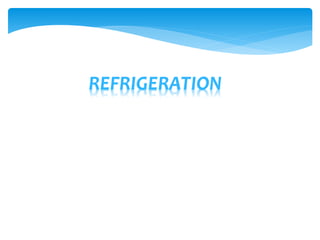This document discusses refrigeration and its various applications and methods. It begins by defining refrigeration as the process of achieving and maintaining a temperature below surroundings through the removal of heat. The main types of refrigeration are then listed as domestic, commercial, industrial, marine, air conditioning, and food preservation. Various natural and early mechanical refrigeration techniques are described, such as the use of icehouses and evaporative cooling. The ideal vapor compression refrigeration cycle is explained through its four processes. Absorption refrigeration using ammonia-water and lithium bromide-water systems is also summarized. Compressor types including reciprocating, rotary, and centrifugal are defined. Key refrigeration system components and their functions are outlined.












































































